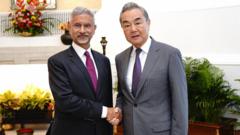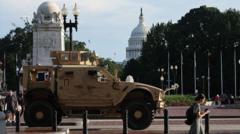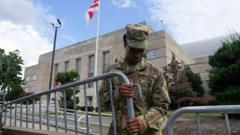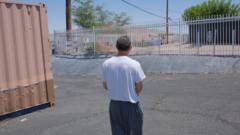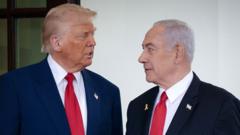The dismantling of migrant housing tents at Guantanamo Bay, initiated under Trump's administration, highlights the disparity between policy intentions and execution. As resources shift and public scrutiny grows, the future of the facility remains uncertain.
Removal of Migrant Tents at Guantanamo Bay Sparks Controversy

Removal of Migrant Tents at Guantanamo Bay Sparks Controversy
Recent satellite images reveal that significant portions of the migrant camp at Guantanamo Bay have been dismantled, raising questions about the effectiveness of the initiative.
Recent satellite imagery indicates that large areas of the migrant camp at Guantanamo Bay Naval Base have been dismantled, contradicting earlier intentions set during President Donald Trump's administration. Initially ordered to accommodate 30,000 migrants shortly after taking office, the camp has seen only a minimal number of individuals actually detained there.
The Pentagon reportedly spent approximately $38 million (£28.7 million) on detention and deportation activities at the base during the first month of operations this year. However, new satellite images show that by April 16, around two-thirds of the approximately 260 tents erected for housing migrants had been removed. A U.S. defense official suggested that this "force adjustment" was a strategic allocation of resources rather than an indication of declining operational readiness.
Construction of the camp began immediately following Trump’s announcement on January 30, with tents rapidly erected until mid-February, when satellite images showed ongoing development until early March. This substantial expansion aimed to bolster the Guantanamo Migrant Operations Center, a facility used previously for holding migrants separate from the high-security prison for suspected terrorists.
As of April 1 and April 10, images reflected a mix of green and white military tents, but by mid-April, the number of tents had reduced significantly to about 175. The exact number of migrants currently housed at the facility remains unclear. Administration representatives, such as White House Deputy Chief of Staff Stephen Miller, continue to assert that a significant number of "foreign terrorist aliens" are still present.
Despite Trump's claims of escalating the migrant capacity, a defense official indicated that the current deployment addressed a population size of about 2,500 detainees. Trump had characterized the expansion as essential for detaining undocumented migrants considered dangerous or those posing national security risks, stating, "Some of them are so bad we don't even trust the countries to hold them."
Since the camp's inception just over two months ago, reports suggest that approximately 400 migrants have been sent to Guantanamo, with over half subsequently returned to the U.S., while others have been deported. A group of five Democratic senators who visited the base criticized the operations, denouncing what they called the "wastefulness" of utilizing military resources for this purpose. They highlighted the financial burden placed upon American taxpayers, with costs amounting to "tens of millions of dollars a month."
As discussions around immigration policy continue to evolve, the fate of the Guantanamo migration facility remains a contentious issue amid burgeoning debates over legality, costs, and the broader implications on due process.

